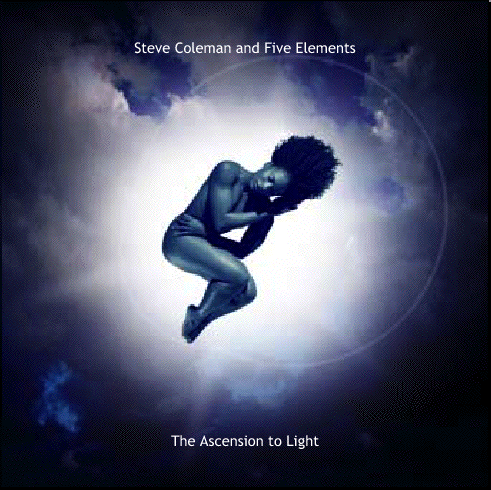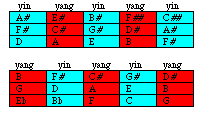
Most of these compositions are studies in sound. The written notes are meant to provide some insight into the intended symbolism in the music. Many people may want to have some idea of what the music is about. Others will prefer to simply listen to the music and supply their own images. The approach that is taken is up to each individual.
1. Reciprocity (February 23, 1999)
Personnel
Steve Coleman, Gary Thomas, Ralph Alessi, Shane Endsley, Vijay Iyer, David Gilmore, Anthony Tidd, Sean Rickman, Valerie Coleman, Toyin Spellman, Mariam Adam, Monica Ellis, Jeff Scott, Min Xiao-Fen
Notes
The concept of reciprocity is everywhere manifest, though not always obvious. The pulsating two tones in the Bass and Pipa (A and G#) represent duality. There are only two keys in this music, all melodic material consists of dual tonal spirals analogous to the Ida and Pingala of yoga practice, the yin and yang of Chinese philosophy, Lunar and Solar energies (G# and A). These spirals alternate as follows (red = yang, blue = yin):

The Drums always represent movement and the principle of becoming. The interplay of Lunar and Solar energies intensifies with the entrance of the long speech-like horn melody/improvisation (similar to a language) played by alto saxophone and Ralph Alessiís trumpet. The harmonic cells played by the woodwind quartet symbolically represent duality progressing to diversity, the progression is a study in balance. Shane Endsley and Jeff Scott play a majestic melody over diversity (woodwinds). After the section that features spontaneous composition of individual musicians the various sonic symbols are played together.
Improvisations
Steve Coleman, Gary Thomas, Shane Endsley, Ralph Alessi, Steve Coleman
2. Embryo (April 25, 1999)
Personnel
Steve Coleman, Shane Endsley, Gregoire Maret, David Gilmore, Anthony Tidd, Sean Rickman
Notes
Again, the stirrings of the Bass and Drums represent movement, in this case primordial movement. This movement organizes itself into the pulse of life, a cosmic heart beat. The structure of the Bass and Guitar figure, ascending E-C-F and E-C-F-Bb is the ëstuff of lifeí which in turn mutates into the melody transforming into spontaneous composition. The improvisations here (as elsewhere on this CD) are not based on anything like chord structures but are evolved from the sonic structure of the music and are musings on the source of life. They are based on the concepts of germination and growth.
Improvisations
Steve Coleman, Sean Rickman, Gregoire Maret, Shane Endsley
3. The 42 Assessors (February 23, 1999)
Personnel
Steve Coleman, Gary Thomas, Ralph Alessi, Shane Endsley, Vijay Iyer, David Gilmore, Anthony Tidd, Sean Rickman, Valerie Coleman, Toyin Spellman, Mariam Adam, Monica Ellis, Jeff Scott, Min Xiao-Fen, Cassandra Wilson, Sophia Wong
Notes
Conceptually, this composition is a holdover from a previous CD (The Sonic Language of Myth). Much of this music is conceived without regard to the particular CD it is contained on; the music is part of a continuum. This composition represents the details of the symbolic journey of the Soul in the Dwat (the Kemetic underworld) and is a sonic exposition of one of the many tests the Soul must meet on the road to Light (cosmic knowledge). The compositions “The Gate” and “Seth” from the CD “The Sonic Language of Myth” also represent part of this process.
The gong, representing openings and closings, announces the Soul being brought before the presence of the 42 Assessors (judges). The Soul speaks the various names of the Assessors and states what has been called “Negative Confessions,” a series of moral declarations stated in the form of “I have not …,” etc. This text is a precursor to the Code of Hammurabi and the Ten Commandments. Far from being a ëconfession of sinsí in the Catholic sense, the various levels of disclosure symbolize the throwing off of obstacles that block the Soulís progress toward further Light. The music is a sonic rendering of this symbolism and the improvisations gradually build as collective statements.
The change in mood that occurs at about 12:50 of the composition represents some aspect of the serenity of Light, a reduction of the aforementioned obstacles.
Voices
Steve Coleman, Sophia Wong
Spoken text
Taken from what is commonly called “The Papyrus of Ani” as contained in the ancient Kemetic text “The Book of Coming Forth By Day” or “The Book of the Master of the Hidden Places.”
Improvisations
Sean Rickman, Min Xiao-Fen, Cassandra Wilson, Vijay Iyer, Jeff Scott, Ralph Alessi, Anthony Tidd, Steve Coleman, Shane Endsley, Gary Thomas, David Gilmore, Toyin Spellman, Valerie Coleman, Mariam Adam
4. Urban (April 25, 1999)
Personnel
Steve Coleman, Shane Endsley, Gregoire Maret, David Gilmore, Anthony Tidd, Sean Rickman
Notes
A study of Life as lived in most major cities in the world.
Improvisations
Sean Rickman, Shane Endsley, Steve Coleman, Gregoire Maret
5. Instantaneous (June 22 1999)
Personnel
Steve Coleman, Gary Thomas, Ralph Alessi, Shane Endsley
Notes
A musical conversation celebrating language, a natural discourse.
Improvisations
All
6. Obscurity (February 21, 1999)
Personnel
Steve Coleman, Gary Thomas, Ralph Alessi, Shane Endsley, Vijay Iyer, David Gilmore, Anthony Tidd, Sean Rickman
Notes
The title of this composition is the translated name of one of the personified principles in ancient Kemetic thinking, sometimes called Amon-Amonet. This music forms a sonic image of layers of uncertainty, delusion, false reality and confusion ó obstacles which hinder the ascension to Light.
Improvisations
Steve Coleman, Ralph Alessi, Gary Thomas, Vijay Iyer, Shane Endsley, David Gilmore, Sean Rickman, Anthony Tidd
7. Cüd Ba-Rith Redraft (February 23, 1999)
Personnel
Steve Coleman, Gary Thomas, Ralph Alessi, Vijay Iyer, David Gilmore, Anthony Tidd, Sean Rickman
Notes
A study in form, using a revamped version of an older composition, dealing with a relation of time symbolizing different dimensions as the simultaneous activity of principles of a dual and triune nature.
Improvisations
Steve Coleman, Ralph Alessi, Gary Thomas
8. Polarity and Equilibrium in a Fluid (February 22, 1999)
Personnel
Steve Coleman, Gary Thomas, Ralph Alessi, Shane Endsley, Vijay Iyer, David Gilmore, Anthony Tidd, Sean Rickman
Notes
Study of the balance of forces and displacement in liquid.
Improvisations
Steve Coleman, Ralph Alessi, Gary Thomas
9. Treading Water (February 24, 1999)
Personnel
Steve Coleman, Gary Thomas, Ralph Alessi, Shane Endsley, Vijay Iyer, David Gilmore, Anthony Tidd, Sean Rickman, Valerie Coleman, Toyin Spellman, Mariam Adam, Monica Ellis, Jeff Scott, Min Xiao-Fen
Notes
Study of the flow of water, ever changing in shape, but not quality. This composition flows through a total complex of tonal relationships. Improvising within the form is similar to the saying ëyou can never step into the same river twiceí. Here, water is meant to symbolize the flow of Life.
Improvisations
Steve Coleman, Shane Endsley, Gary Thomas, Ralph Alessi, David Gilmore
Thanks
Special thanks to Thomas Goodwin for his help and advice with some of the spiritual/philosophical information that is contained herein. Thanks to Carl Walker and Terence Nicholson for their work in the pre-production of “The 42 Assessors.”
Much of this music is a continuation of processes that began with the material recorded on the “CD The Sonic Language of Myth”. However, without the work done and represented on previous CDs (“Genesis”, “The Opening of the Way”, etc.) this work would not now be possible. Therefore, the contributions of all of the musicians and other people involved with working on the previous recordings, tours, rehearsals, etc., is greatly appreciated.
Steve Coleman
The Ascension to Light
Personnel
Steve Coleman Alto saxophone, clavé, Chinese gong, vocals, composer
Gary Thomas Tenor saxophone
Ralph Alessi Trumpet
Shane Endsley Trumpet
Vijay Iyer Piano
David Gilmore Guitar
Anthony Tidd Bass
Sean Rickman Drums
Gregoire Maret Harmonica
Thomas Goodwin Philosophy
Min Xiao-Fen Pipa
Cassandra Wilson Vocals
Sophia Wong Vocals
Imani Winds:
Valerie Coleman Flute and Piccolo
Toyin Spellman Oboe
Mariam Adam Clarinet
Jeff Scott French Horn
Monica Ellis Bassoon
Credits
Recording Engineer Joseph Marciano
Assistant Engineers Michael and Nancy Marciano
Mixed by Steve Coleman and Joseph Marciano
Mastered by Nicholas Prout
Recorded at Systems Two Recording Studios, Brooklyn, NY February, April and June 1999
Mixed at Systems Two Recording Studios, Brooklyn, NY April, June and September 1999
Mastered at Foothill Digital, New York, NY on October 1, 1999
All songs composed and arranged by Steve Coleman and published by Goemon Publishing Co. (SESAC / GEMA).
Steve Coleman plays Vandoren mouthpieces and reeds.
The woodwind quintet (flute, oboe, clarinet, bassoon, french horn) play together as a group called Imani Winds.
Producer Steve Coleman
Assistant Producer Sophia Wong
Information Consultant Tom Goodwin
Executive Producer Daniel Baumgarten
Overall Project Coordinator Rémi Sommers
Cover Photography Caroline Mardok
Model on CD booklet Leslie Salmon
Cover Design and Layout Rebus
Liner Notes Steve Coleman
Download
Music available on the download page.